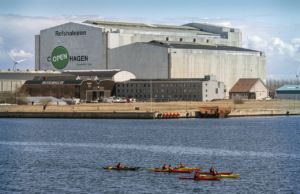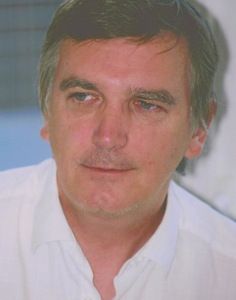Opinion
Sing me the old Copenhagen shipyard blues: back when B&W ruled the waves
Frank Sonderborg
This article is more than 4 years old.
Today we can again visit the island of Refshaleøen by boat, retracing the daily voyage of the dockers who grew to epitomise the working ethos of Copenhagen

Calm crossing for once (photo: News Oresund)
Have you ever visited Copenhagen and stood and admired the ‘Little Mermaid’? Because if you raised your head a little, you would be staring straight across at Refshaleøen and, what was at one time, the mighty B&W shipyards.
Once it was the biggest employer in the capital region – working there was the very essence of being a Copenhagener. The shipyard workers were heroes, famous for their resistance to the German Occupation. And as far as Danish labour relations were concerned, when the B&W men in blue went on strike, everybody went on strike.
It’s all long gone now. Sandbagged by American bankers – they’d loaned the shipyard money and wanted it back. The Socialdemokratiet government was supposed to step in and save the day, but it never happened, and the plug was pulled on a bit of Copenhagen history, and a big part of its identity.
Human steam-engine
It was never my intention to work in a shipyard. I was heading for Bondi Beach, Australia, the land of wombats and Men’s Lib. But the best-laid plans of mice and wombats can often go agley. Which is why, it found me, one cold December morning, heading for the shipyards.
The train stops at Østerport. From there, we are out and running, down that long tree-lined road towards Churchill’s Park and finally Toldboden, the cold air turning our heavy breathing into a plume of steam – like some unnatural human steam-engine
We swing left and head past the Resistance War Museum that honours the memory of Anders Lassen, a British SAS legend and Victoria Cross winner, with the seven-pointed star of ‘AP Møller, Lord and Master of the Container Shipping Universe” beckoning in the distance.
Then a final dash to the boat, whose lights we can see at the landing steps, to catch the B&W ferry across the harbour to the great assembly yards of B&W.
The ferry boats from Holmen Naval dockyard would come and go, but they were winding down, while the B&W yards were booming.
Saucers in the soup
I would learn that I could afford to miss one boat and still be early for the 06:45 am start.
In the summer we’d sail around the ‘Dannebrog’, the Danish Queen’s majestic yacht, waving to the bored sailors on deck. Behind us, the beautiful city of Copenhagen, slowly coming to life in the early morning sun, and in front, the giant cranes and assembly halls of B&W – like prehistoric monsters from another age.
In winter, the trip was a bummer though. In the heavy fog, we’d sight the incoming Bornholm ferry, looking like a UFO hovering over the water, and then sigh with relief as the giant ghost ship slid by.
Heavy storms at sea would routinely push icy black waters back up into Copenhagen Harbour, transforming our trip across the harbour into a rollercoaster ride of unimaginable terror.
The ever-present thought, at the back of all our minds, is that one black morning, among howling winds and razor-sharp sleet, we’d get swatted by an incoming coaster.
Original blues brothers
But then, we were B&W tough guys. It was never going to happen.
Every morning we’d make it over and run to our locker rooms and change into the blue boiler-suits – the trademark look of the B&W ship-worker. The B&W canteen in the early morning back in those days was one of the great wonders of Copenhagen.
The workforce was multi-racial, and the list of attending nations was endless: the ultimate melting pot. But when the blue boiler-suit went on, we became blues brothers together – all children of Adam and Eve, the people or the monkey’s, depending on your belief.
We lived in Denmark, both a country and state of mind, and while we spoke Danish, when thrown into the crucible of the B&W shipyard, the Danish language took an unmerciful hammering.
One could still recognise the similarities between it and the inner-city Vesterbrogade variety. But from there to Queen Margaret’s beautiful Danish was a quantum leap. The shipyard version was vibrant – more a type of Zapata revolutionary, cantina language – and full of shrugs, and ‘nudge nudge, wink wink, say no more’ types of innuendo.
Sentences invariably involved hand-chopping movements and started with “Op i røven,”
Mirth with Murph
I had coffee every morning with Murph, whose claim to fame was having played cricket for Manchester Boys. And ‘English Graham’, who had played tennis with somebody well known in California.
Also in our group was Fernando, a Spaniard who’d been raised in the USSR. Just before Franco had taken over in Spain, 6,000 children were sent away to Russia to ensure they were raised as true communists. There they stayed throughout World War II and beyond.
Fernando was fully brainwashed and would not hear any criticism of the peace-loving Soviet Socialistic Republics, so one day when Murph injured his leg and was limping badly, he asked: “Daw-lee Been?”
“Nej,” said Murph. “Daw-lee Parton.”
Fernando turned to me totally confused: “Hvaa … Daw-lee Par-Don?” I explained it was a famous US country singer with gigantic mammary glands, but it didn’t seem to clarify the situation at all.
Fernando went away still confused and none the wiser.
In Dracula’s lair
I remember on my first day driving down from the port-gates on the tractor-bus to the dry dock. There was a building full of wooden tool-boxes stacked up row after row.
The thought that raced through my cold numb brain was: “Welcome to Castle Dracula.”
The inside of a new bulk-carrier was a very overwhelming experience too.
From the coffins of Castle Dracula, with an outside temperature hitting minus 25 degrees, into a vast cathedral-like environment – a place of bright lights and extremely dark places.
With its scaffolding and the hanging lights it could easily have been mistaken for some enormous Egyptian excavation.
Different breeds of sheep
The shipyard was a hard and sometimes a very dangerous place to work. Hard hats were needed, as you could easily end up with a dropped glowing bolt going right through your brain.
A new breed of shop stewards, with their crisp, well ironed boiler-suits and dogma, was emerging. Their mantra of “The Company is allowed to make a profit” was in stark contrast to the dirty recycled container city look favoured by the old breed.
In the canteen we would gather to hear their latest wage negotiation report. If we didn’t like it, we would start banging tables and shout that universal sheep chorus of objection: “Baaaaaaaaaaaaaaah.”
Newbie workers were met with a rendition of Pink Floyd’s ‘Welcome to the Machine.’
Farvel Floyd, hello foodies
B&W, the heartbeat of the Copenhagen worker, closed its gates in the spring of 1996.
In its wake, Den Gammel Svejsehall (the old welding hall) is now a modern museum, and its giant assembly hall was used to stage the impressive 2014 Eurovision Song Contest. The annual heavy metal festival Copenhell, meanwhile, has found a home just outside its walls.
You can get street food and craft beer in the foodie markets of Reffen and, since earlier this month, you can even turn up by boat if you’re prepared to pay the asking price.
It’s a route known all too well by generations of workers at the dockers. Only this time the melting pot of cultures they’re heading for is a serving of quinoa, edamame beans and IPA beer, not the hotpotch of happy-go-lucky Charlies whose resoluteness made this country proud.

About
Frank Sonderborg
Frank Sonderborg was born in Ireland, lives in the UK and does his best to write interesting stories. This particular tale is based on his experience working at the B&W shipyards in the 1970s. His short stories have appeared in various UK and US publications. He is currently working on a fictional book about the Irish War of Independence.










































